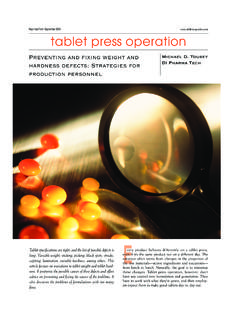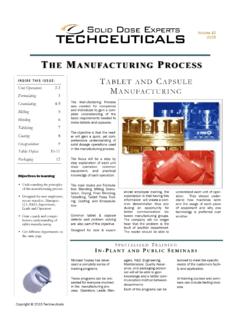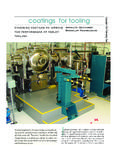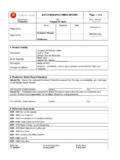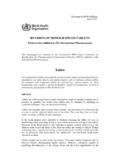Transcription of Tablet Coating Musts - Techceuticals
1 When it comes to Coating tablets there are Musts that really count and then there are the other things. The ability to coat tablets well is often considered more of an art than a science. Traditional coat-ing uses a sugar solution that is applied one layer at a time through a process called the three D s; dose, distribute, and dry. Once at the proper temperature the tumbling cores are exposed to an initial dose of solution which is added by the use of a (soup) ladle, pumped, or a controlled spray nozzle. The solution is added in steps and after each ad-dition the cores are continually tumbled to distribute the solution evenly while forced air is blown over the surface of the bed of cores to facilitate the drying process.
2 This process of dose, distribute, and dry is done layer by layer until the required 50-100% weight gain achieves the desired buildup and appearance. Many companies made their own proprietary solution that was kept a closely guarded secret. The art was knowing when the cores were ready for the next layer. If solution was added too soon the cores would stick to each other pulling the Coating off other cores. If the previous Coating layer was over-dried then the next layer wouldn t adhere properly creating blemishes and rough sur-faces, resulting in a defective Coating . In the old days coat-ing a Tablet was an art, having a lot of touch and feel. Today coatings are demanding because they must do more than a sugar coat and taste mask.
3 Nowadays most tablets are coated with a thin film, referred to as film Coating . A typical film is either just a thin clear Coating or a more controlled build up of color Coating , most commonly a 3% build up of total Tablet coatings provide much more than just being a sweet taste and a protective layer. From a manufactur-ing standpoint a film Coating elimi-nates dust, makes the Tablet tougher, and improves packaging capabilities. From the users standpoint it improves stability, increased Tablet hardness, can contain a drug layer, controls the re-lease rates, and improves the appearance. The process starts with tumbling to elimi-nate the dust. Dust can create poor adhesion of the initial layer preventing the solution from impinging into the surface of the Tablet which would easily peel away regardless of how many layers were added.
4 If the first coat isn t good no amount of subsequent layers will overcome a weak foundation. Once dedusted the known volume of cores ( tablets ) are loaded into a drum called a Coating pan to create a batch of product. The cores are exposed to treated and conditioned air, this air stabilizes the temperature of the cores and the Coating chamber to enable accurate adhesion of a sprayed solution. The more we control these conditions the more likely the process will become a predictive one. Film Coating is not at all like sugar Coating in that as soon as the solution (dose ) hits the Tablet in film Coating it should dry immediately. The prospect of spreading the solution across the surface like sugar Coating would cause damage to the Tablet .
5 To make the art of Coating more scien-tific, predictable, and most importantly repeatable here are key elements. MustsTablet Hardness: The greatest influence of the success in film Coating is the consistency of Tablet hardness. The delivery of a sprayed Coating solution onto a variable range of Tablet surface hardness will net poor results at best. Soft tablets will often result in a dull Coating and risk the poten-tial for erosion. tablets that are too hard don t allow the solution to lock into the surface of the Tablet and the Coating will often peel off. These are extreme examples, but the subtle variations in Tablet hardness can also cause picking, mottling, and reduce the Tablet strength. If I were an inventor I would want a Tablet sur-face hardness detector for the best Coating results.
6 Traditional hardness testing is not as predictable when it comes to a film Coating . startup: Load: Be careful to load tablets and look for broken, chipped, and other de-fects as the tablets are being loaded. Be sure to position the pan so the tablets do not hit the mixing baffles or anything else that could dame or chip them. One broken or chipped Tablet can ruin the entire batch. Also tablets need to settle after compression for at Tablet Coating MustsA quick look at what you must know to be successful By Mike Tousey, Techceuticals 26 may 2014 | Pharmaceutical Processing coatingTablet cores are too soft, tablets breaks apart too easily 12 -24 hours or the consistency of Coating will not be predictable and may peel or frost.
7 Dedust: Turn on the exhaust blower and pull the excess dust off the tablets . Jog the pan at a very slow speed and make sure that Tablet flash or extrusions are removed with the dust. Preheat: When it comes to film Coating the tablets must be preheated or the Coating will not dry immediately. The sweet spot is generally around 43-45 C. Dropping below 42 and going over 48 C is asking for problems (there are always ex-ceptions). Remember that when the spray cycle begins it will have a cooling effect. If temperatures are too high the Coating may flash off and not impinge into the surface. Avoid Black Marks: Sometimes it is helpful to preheat the Coating pan before loading tablets that get black marks from the stainless steel.
8 Many calcium based products mark very easily. To avoid the marks there are two methods; preheat the pan or coat the pan with the same solution used to coat the RPM: Initially the pan should be jogged to dedust, do not run the pan continuously prior to turning the spray on to avoid erosion. Tablet shape and bed depth have an im-pact on the flow of the cores within the pan. Generally start up slow at around 4-5 rpm once the initial Coating is applied then speed can and should be increased. In general the ob-jective is a tranquil bed of Tablet cores, we do not want to see tablets jumping all over the spraying Coating Solution: Prepare the Coating solution ahead of time to allow the suspension to adequately dissolve.
9 This means the solution should be prepared a minimum of 60 min-utes before hand. Make certain the solution is free of lumps and air bubbles. Most solutions require continuous mixing throughout the process. Again the name of the game is repro-ducibility batch to batch. Establishing a solution hold time is a good idea; and the ideal range is typically 2-24 hours. The wider the range often times the less predictable the results. Spray too soon and the guns clog easily, wait too long and the viscosity changes due to evaporation. The hold time is depen-dent on the type of solution, water or solvent. The window for solvents based Coating solutions needs to be Spray Rate: The objective is to spray a thin film across the surface of the Tablet bed to get even coverage a little at a time.
10 We want small amounts of coverage multiple times, not the other way around. The spray rate depends on the solution and the core. Generally solution rates are between 40-120 ml/minute per gun. The spray should dry on contact. Too much air pressure will cause spray drying, orange peel, and poor coverage. While not enough air will cause over wetting resulting in sticking, picking, peeling and worse. Again the key is Air: The Coating pan has small holes to allow air to dry the Coating solution. The air supply and exhaust pressure is balanced to minimize the rubbing of the tablets against the perforated pan surface. If supply air was only blown into the pan the spray would go everywhere. If exhaust air was only pulled out of the pan the air pressure would damage the tab-lets.

